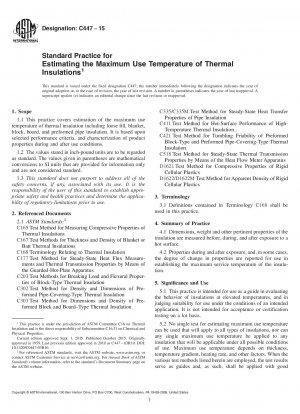ASTM C447-15
Standard Practice for Estimating the Maximum Use Temperature of Thermal Insulations
- Standard No.
- ASTM C447-15
- Release Date
- 2015
- Published By
- American Society for Testing and Materials (ASTM)
- Status
- Replace By
- ASTM C447-15(2022)
- Latest
- ASTM C447-15(2022)
- Scope
5.1 This practice is intended for use as a guide in evaluating the behavior of insulations at elevated temperatures, and in judging suitability for use under the conditions of an intended application. It is not intended for acceptance or certification testing on a lot basis.
5.2 No single test for estimating maximum use temperature can be used that will apply to all types of insulations, nor can any single maximum use temperature be applied to any insulation that will be applicable under all possible conditions of use. Maximum use temperature depends on thickness, temperature gradient, heating rate, and other factors. When the various test methods listed herein are employed, the test results serve as guides and, as such, shall be applied with good engineering judgment in arriving at an acceptable temperature limit for the products and applications being considered.
5.3 The criteria used to establish acceptable performance is provided in the material specification or as agreed upon by the purchaser and seller.
5.4 In most cases, the properties covered by the applicable material standards (for example, thermal transmission, strength, and so forth) are the properties important to the end use of the product. Major changes in those properties resulting from in-service conditions often causes failure or substandard performance of the installed system.
5.5 Unless removal and reuse of the insulation is an important consideration, properties that relate primarily to handling and installation shall be eliminated from the evaluation.
Note 1: Installation assemblies: some systems create conditions that affect the performance from the data obtained in the test procedures of this practice.
5.6 The listing of a test procedure in this practice does not imply that the performance of that particular procedure is required. Only those tests which are relevant to the requirements of the application involved, or which are agreed upon by the purchaser and the seller are preformed.
5.7 Most of the changes that occur in the functionally important characteristics of all types of thermal insulation during service result from changes in the matrix or binder system first, followed by changes in the bulk filler materials where such fillers have been used.
5.7.1 In general, these changes are temperature-dependent and the major portion of the change takes place quickly once the critical temperature has been reached.
5.7.2 Typically, organic thermoplastic materials or binders will change in the 140 to 240°F (60 to 116°C) temperature range. Thermosetting organic materials or binders will start to deteriorate above 350°F (177°C). Hydrated inorganic binders such as clays, Portland and lumnite cements, gypsum, sodium silicates, oxysulfates, and oxychlorides lose varying amounts of water of crystallization at temperatures from 250 to 900°F (121 to 482......
ASTM C447-15 Referenced Document
- ASTM C165 Standard Test Method for Measuring Compressive Properties of Thermal Insulations
- ASTM C167 Standard Test Methods for Thickness and Density of Blanket or Batt Thermal Insulations
- ASTM C168 Standard Terminology Relating to Thermal Insulation
- ASTM C177 Standard Test Method for Steady-State Heat Flux Measurements and Thermal Transmission Properties by Means of the Guarded-Hot-Plate Apparatus
- ASTM C203 Standard Test Methods for Breaking Load and Flexural Properties of Block-Type Thermal Insulation
- ASTM C302 Standard Test Method for Density and Dimensions of Preformed Pipe-Covering-Type Thermal Insulation
- ASTM C303 Standard Test Method for Dimensions and Density of Preformed Block and Broad-Type Thermal Insulation
- ASTM C335/C335M Standard Test Method for Steady-State Heat Transfer Properties of Pipe Insulation
- ASTM C411 Standard Test Method for Hot-Surface Performance of High-Temperature Thermal Insulation
- ASTM C421 Standard Test Method for Tumbling Friability of Preformed Block-Type Thermal Insulation
- ASTM C518 Standard Test Method for Steady-State Thermal Transmission Properties by Means of the Heat Flow Meter Apparatus
- ASTM D1621 Standard Test Method for Compressive Properties of Rigid Cellular Plastics
- ASTM D1622/D1622M Standard Test Method for Apparent Density of Rigid Cellular Plastics
ASTM C447-15 history
- 2022 ASTM C447-15(2022) Standard Practice for Estimating the Maximum Use Temperature of Thermal Insulations
- 2015 ASTM C447-15 Standard Practice for Estimating the Maximum Use Temperature of Thermal Insulations
- 2003 ASTM C447-03(2010) Standard Practice for Estimating the Maximum Use Temperature of Thermal Insulations
- 2003 ASTM C447-03 Standard Practice for Estimating the Maximum Use Temperature of Thermal Insulations
- 1985 ASTM C447-85(2001)e1 Standard Practice for Estimating the Maximum Use Temperature of Thermal Insulations
- 1985 ASTM C447-85(1995)e1 Standard Practice for Estimating the Maximum Use Temperature of Thermal Insulations

Copyright ©2024 All Rights Reserved